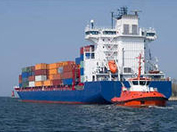Baltic ports to increase their cargo turnover volumes
 What attracts Russian investors investing in the development of ports in the Baltic states? Probably favorable working conditions, developed road and railroad networks, as well as European service. These and other indicators contribute to development of harbors in the Baltic states, whose annual growth of cargo turnover is already over 10%.
What attracts Russian investors investing in the development of ports in the Baltic states? Probably favorable working conditions, developed road and railroad networks, as well as European service. These and other indicators contribute to development of harbors in the Baltic states, whose annual growth of cargo turnover is already over 10%.
Capacity buildup
Transport Minister Aivis Ronis said at the traditional Baltic Forum in Riga that cargo turnover in ports and railroads showed unheard-of growth in 2012. At the same time 90% of cargoes are coming from Russia and Belarus and only 10% are transported in the opposite direction. Most often fertilizers, Russian coal, oil products and grain are transshipped.
The Minister deems it possible to transship more containers in the near future because, as he says, there are all prerequisites for this. In the future, the National Container Company of Russia plans to develop the Free Port of Riga, the indices of which in 2011 showed an increase of 11.8% (the total volume was 34 million tons). Container terminal intended to handle not less than 540 thousand TEU annually will be built on the territory of this port. For this purpose, the company has leased 160 hectares of land. According to expert forecasts, investments in the project will amount to approximately 200 million dollars.
The Latvian Railway is keeping up with the ports with 59 million tons of cargo in 2011 including 20 million tons of coal from Russia. According to Ugis Magonis, LZD president, freight trains cross the border to Russia every 20 minutes.
In the long term the second phase of construction of the coal terminal in Ventspils, which cooperates with the Zachernaya mine in Kuzbass, will start very soon. Working since 2008, the terminal at the moment handles 6 million tons of coal annually, and after the construction is completed, this volume will increase to 10.5 million tons per year. To understand how big this volume can be considered, it is enough to remember that the coal terminal in Ust-Luga transshipped 12.5 million tons per year. Other terminals also work in Ventspils – terminal on transshipment of grain with capacity 1.5 million tons, working with export deliveries from Kazakhstan and Russia, and terminal on transshipment of potash fertilizers, which capacity reaches 7.5 million tons.
In the near future Ventspils will see active operations of RTL company, which currently manages a multifunctional terminal on the territory of 30 hectares. The terminal specializes in handling container and ro-ro cargo. The company has additionally leased a 100 hectare plot of land in the so called Northern Port in order to build a container terminal on its territory as well as a complex designed for car transshipment and a functional site for bulk products. As Guntis Drunkka, the manager of Ventspils port, said, RTL continues looking for a third investor as there is a scheme ready to implement the project.
The secret of Russian business success in Latvia lies in the country's favorable location in the Baltic Sea. Ventspils and Liepaja are ice-free ports that do not require icebreaker escort in winter and operate as special economic zones, providing tax benefits. Undoubtedly, investors are attracted by the fact that many goods are not subject to VAT, and initially in the port of Ventspils or Riga there is no need to pay property tax. Besides, the ports are notable for optimal water area depth, sufficient for accepting ships with maximum draught. Therefore these ports successfully accept ships passing through Danish straits. The Baltic states are not afraid of competition with the Russian ports. On the other hand, GuntisDrunkka is sure that Russian cargoes will be enough to meet demands of all ports, despite the popularity of St. Petersburg and Ust-Luga. Alexander Goloviznin, Deputy Director General of Ust-Luga Company, is sure that Baltic ports will always have their own cargoes, and reasonable competition in international logistics only contributes to development of logistics. Goloviznin said that many Russian companies initially focused on the Baltic ports, building their terminals there. The current year of 2012 has also demonstrated growth of transshipment volumes. For example, Latvian railroads has transported 25 million tons of cargo this year, and the total volume is expected to be 65 million tons by the end of the year. The growth of cargo turnover in the port of Ventspils was +21% compared to last year (the current volume is 11.8 million tons). Also the total cargo turnover of Riga grew by 14.89% in the quarter with the volume of 12.52 million tons. All six ports of Latvia, Estonia and Lithuania handled 38.4 million tons of cargo in the first quarter of 2012 with the growth of +58% compared with 2011.

 EN
EN PL
PL EE
EE








